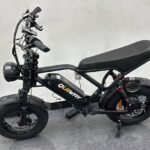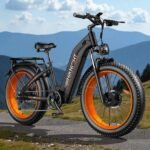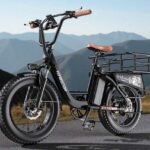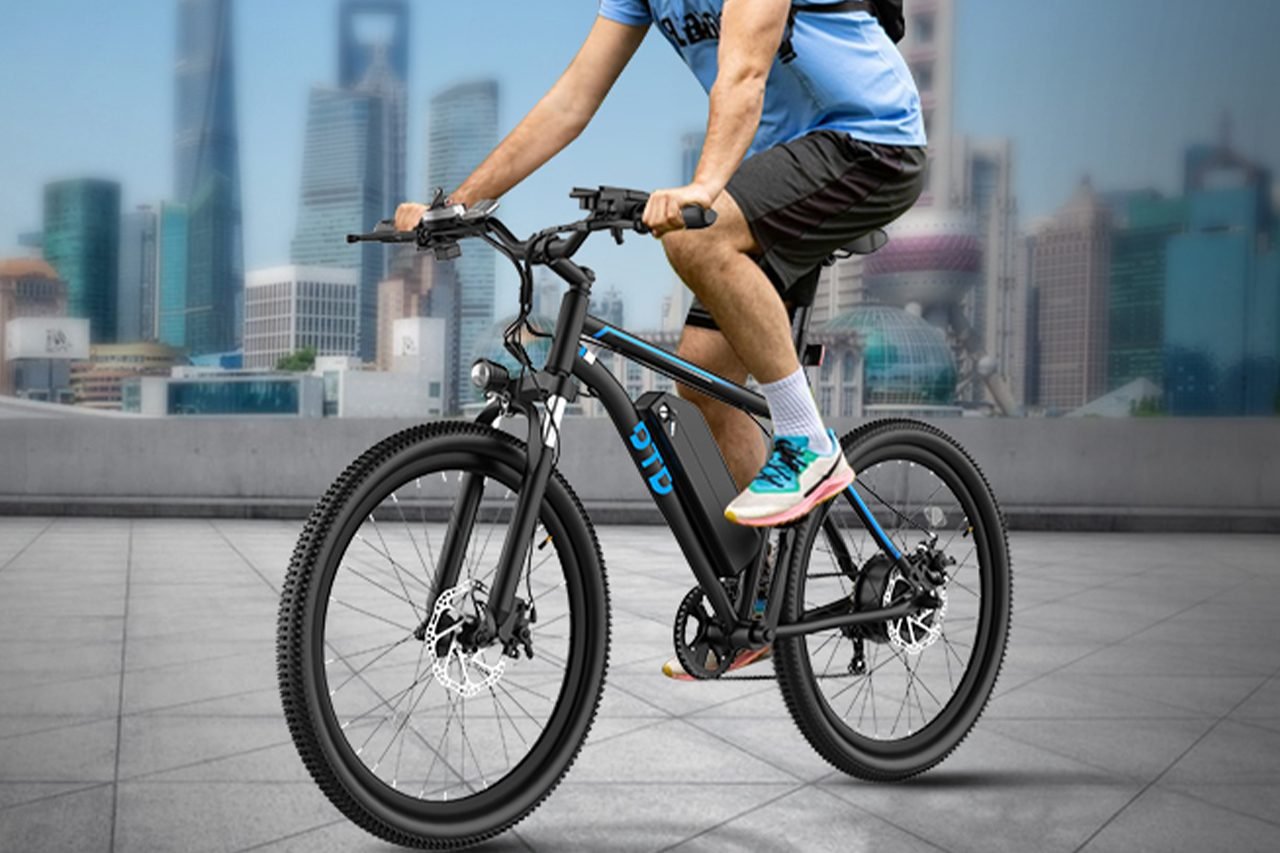
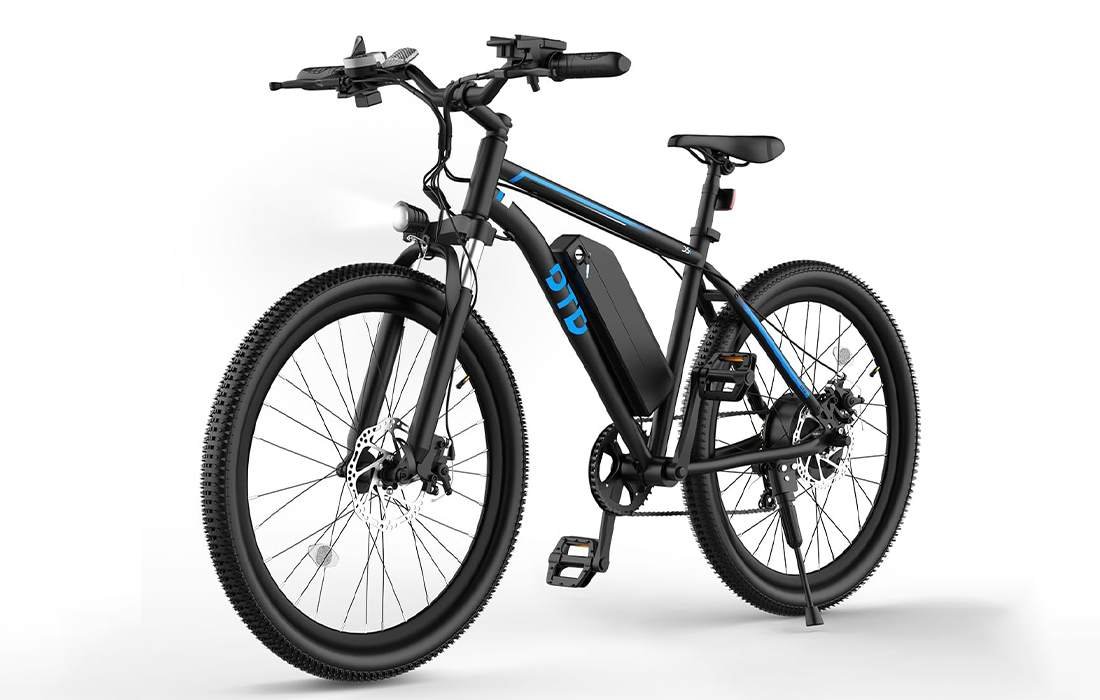
OTD DS1 Electric Bike — 48V Punch, 28MPH Speed, UL-Certified
A lively 26″ hardtail that flattens hills and keeps daily rides simple—real power, removable battery, and thoughtful extras for commuters.
- 800W peak brushless hub motor with up to 28 mph top speed
- 48V 13Ah (624Wh) removable battery — up to 45 miles in PAS
- Shimano 7-speed, LCD display, 3W headlight & electronic bell
- 26×2.1″ agile tires, front suspension, 265 lb max load
- Motor
- 800W peak hub
- Battery
- 48V 13Ah (624Wh)
- Top Speed
- Up to 28 mph
- Range
- Up to 45 mi (PAS)
For riders 5’–6’6″ • 57.1 lb bike • Quick-release front wheel • Phone holder included
If you’re shopping for your first electric mountain-style bike and want something simple, safe, and genuinely fun, the OTD DS1 is built to be that “grab-and-go” daily rider. It’s a hardtail 26-inch e-bike with an 800W peak rear hub motor, a 48V 13Ah (624Wh) removable battery, and the familiar Shimano 7-speed drivetrain. OTD also includes a few quality-of-life touches you don’t always see at this level—UL 2849 electrical safety certification, a backlit LCD, and even a bar-mount phone holder for easy navigation.
On paper, the DS1 checks a lot of boxes: claimed 28 mph top speed (throttle available), an estimated 45 miles of range in PAS, and front suspension to take the sting out of city cracks and park-path roots. In hand, it presents like a straightforward, budget-friendly trail/commuter hybrid—clean lines, removable battery, mechanical disc brakes, and a sensible 26×2.1″ tire spec that keeps rolling weight down and handling predictable.
OTD positions the DS1 as an all-rounder—city, mountain, snow, beach are the splashy keywords on the box. That’s marketing optimism, of course, but the frame and component mix do lend themselves to mixed-surface rides: paved paths, crushed gravel, neighborhood hills, and a bit of smooth singletrack with moderation. It’s not a full-suspension bruiser, and it doesn’t pretend to be one. It’s a daily e-bike that tries to make the essentials easy—and for the most part, it succeeds.
Is OTD DS1 for you?
The DS1 solves a very common problem: you want the speed and hill-flattening power of an e-bike without spending big or wrestling with complicated features. With three riding modes (pedal-assist, throttle-only, and pedal-only), it adapts to how you feel that day—cruise without sweating, or add some cardio on PAS 1–3 and stretch your range.
It’s a great fit if you:
- Want a budget-friendly e-bike that still feels lively.
- Need real hill help beyond what 250–350W setups offer.
- Prefer a lighter 26″ wheel for nimble handling and easy storage.
- Value UL 2849 safety certification and a removable battery you can charge indoors.
- Appreciate a plug-and-ride package with included tools and even a phone mount.
It’s less ideal if you:
- Expect premium features like hydraulic disc brakes, torque sensors, or a color display.
- Plan to ride technical trails or steep, loose descents regularly—this is a hardtail with city-leaning tires and geometry.
- Need huge range at high speed; the 624Wh pack is solid for commuting and recreation, but speed always eats miles.
From a buyer’s lens, the DS1 sits firmly in the budget segment. It’s beginner-friendly, straightforward to assemble, and easy to live with. Tinkerers can always upgrade brakes, tires, or saddle later; out of the box, it’s ready to ride.
What We Like About OTD DS1
The motor/battery pairing hits a sweet spot. The 48V system delivers more punch off the line than entry-level 36V bikes, and the 800W peak helps the DS1 feel confident through rolling hills. On mixed routes, PAS 2–3 provides steady 15–20 mph cruising without spiking consumption, while PAS 4–5 and throttle deliver that satisfying surge when you want it. OTD’s claim of up to 45 miles in PAS is realistic if you pedal and ride conservatively; expect the upper-20s to mid-30s miles when mixing speeds and stops in real city use—respectable for a 624Wh pack.
Handling is another highlight. The 26×2.1″ tires keep steering quick and parking-lot maneuvering simple, and the front suspension fork (with thickened springs) takes the edge off potholes and curb cuts. The 57.1 lb weight is manageable for apartment stairs and car racks in a way that 70-plus-pound fat-tire bikes aren’t. The adjustable stem and seatpost help a wide range of riders (OTD suggests 5’–6’6″), and the 265 lb load rating is solid for everyday use.
Daily usability is strong: a backlit LCD shows speed, battery, mileage, and assist level at a glance; the electronic bell and 3W headlight increase awareness and visibility; and the included phone holder is one of those small extras you’ll actually use. UL 2849 certification provides peace of mind about the electrical system—a major plus when you charge indoors. Assembly is straightforward with the provided tools and quick-release front wheel.
What We Don’t Like About OTD DS1
At this price, compromises are expected, and the DS1 has a few. The mechanical disc brakes stop reliably in the dry, but they require more hand effort than hydraulic systems and can squeal when wet. If you ride hilly routes or carry heavier loads, an eventual brake upgrade is worth budgeting for.
The cadence-based pedal assist is smooth but not as natural-feeling as a torque sensor. When you first start pedaling, there’s a brief on/off sensation before the assist settles, especially at higher levels. It’s common for the class, but riders coming from mid-drive or torque-sensor bikes will notice. Likewise, the 26×2.1″ tires prioritize agility over cushion; they’re fine for paved and hardpack trails, but if your routes include loose gravel or sand, a 2.3–2.4″ tread with a more open pattern could transform traction and comfort.
Lastly, the marketing claims around hill grades can be a little optimistic. OTD references climbs “up to about 20°” in copy and shows 30° in a graphic. Real-world success depends on rider weight, starting speed, assist level, and tire surface. It will pull up moderate climbs far better than a 350–500W bike, but ultra-steep pitches still demand pedaling and momentum.
Pros & Cons
| Pros | Cons |
|---|---|
| Punchy 800W peak rear hub motor for zippy starts and confident hills | Mechanical discs need more hand force; hydros would be a nice upgrade |
| 48V 13Ah (624Wh) battery with realistic PAS range for daily commuting | Cadence sensor feels less natural than torque-based assist |
| UL 2849 certified electrical system for added charging peace of mind | Stock 26×2.1″ tires are agile but not ideal for loose surfaces |
| 28 mph capability (with throttle and high PAS) for fast commutes | Marketing hill-grade claims are optimistic—keep expectations reasonable |
| Adjustable stem/seat fits a wide height range; 265 lb max load | No fenders or rear rack included; budget for accessories if commuting |
| Phone holder, tools, quick-release wheel included out of the box |
What’s Included?
- OTD DS1 electric bike (26″ hardtail)
- 48V 13Ah removable battery
- Battery keys ×2
- Charger
- LCD display (bar-mounted)
- Front headlight (3W)
- Electronic bell
- Mobile phone holder
- Front wheel quick-release lever
- Kickstand
- User manual
- Pedals ×2
- Reflectors ×2
- Multifunction open-end wrench
- 3 mm and 5 mm Allen keys + cross screwdriver
Package impressions: This is a thoughtful starter kit. You can assemble and ride without a trip to the hardware store, and the included phone holder is genuinely useful for navigation. I’d love to see basic fenders in the box, and a rear rack would make commuting more turnkey, but those are common add-ons in this price range. The quick-release front wheel speeds assembly and makes car transport easier.
Technical Specifications
| Specification | Detail |
|---|---|
| Motor | Rear hub, 800W peak brushless |
| Battery | 48V 13Ah (624Wh), removable |
| Charging Time | ~5–6 hours |
| Top Speed | Up to 28 mph (throttle/PAS) |
| Range (claimed) | Up to 45 miles (PAS), ~28 miles throttle |
| Assist / Modes | Pedal-assist (multi-level), throttle-only, pedal-only |
| Display | Backlit LCD with speed, battery, mileage, gear |
| Drivetrain | Shimano 7-speed, trigger shifter |
| Brakes | Mechanical disc |
| Frame | Aluminum hardtail |
| Suspension | Front fork with thickened springs |
| Wheels/Tires | 26×2.1″ |
| Bike Weight | 57.1 lb |
| Max Rider Weight | 265 lb |
| Rider Height | Recommended 5’–6’6″ |
| Dimensions | Length 67.5″; handlebar height 39″; seat height 33–40″ (approx.) |
| Seatpost Travel | Up to 7″ |
| Lighting / Bell | 3W headlight; electronic bell |
| Certification | UL 2849 |
| Included Extras | Phone holder, tools, kickstand, reflectors |
Features
- 48V electrical system for stronger hill performance than typical 36V setups.
- 800W peak motor with quick, confident acceleration in traffic.
- Removable 624Wh battery—charge at your desk or inside your apartment.
- Three riding modes to match effort with distance and terrain.
- Backlit LCD display with real-time speed, assist level, trip, and odometer.
- Shimano 7-speed drivetrain with trigger shifter for intuitive gear changes.
- Front suspension fork to tame curbs and rough pavement.
- Mechanical disc brakes for dependable stopping and simple maintenance.
- 26×2.1″ tires that steer quickly and keep weight manageable.
- Adjustable stem and seatpost to dial in fit for a wide rider range.
- 3W LED headlight & electronic bell for safety and visibility.
- UL 2849 certification covering the full e-system’s electrical safety.
- Phone holder included to keep navigation in view.
Feature impressions: The DS1’s spec is smartly balanced for its role. The 48V system is the star; it lifts the whole ride experience, especially on hills where 36V bikes often bog down. The LCD is basic but legible. The mechanical discs are the clearest budget tell—they work, but hydraulic brakes would better match the DS1’s speed potential. Tires are versatile for city/gravel use; swap to grippier tread if you plan to ride off-pavement often. Overall, this is a thoughtfully curated package for a first or second e-bike.
Real-World Ride Notes
Fit & comfort: With the adjustable cockpit and seat, it’s easy to get comfortable. The geometry leans slightly forward, which feels sporty without being aggressive. The hardtail frame and 2.1″ tires won’t erase all chatter, but the front suspension and a sensible saddle pressure go a long way on commutes.
Speed & control: The DS1 is quick to 20 mph in PAS 3–4 and will push toward its upper-20s mph potential as you level up assist. Steering is predictable, and the 26″ wheels help it feel flickable through traffic. At higher speeds, smooth inputs and a two-finger brake habit keep things composed.
Climbing: This is where the 48V / 800W peak motor shines. On moderate grades, PAS 3–5 delivers steady pull with light pedaling. Very steep hills are doable with momentum and gear management. If your daily route includes long, sustained climbs, consider fitting a larger rear cassette (if compatibility allows) or just plan to use higher assist levels and contribute some pedaling.
Range management: Like any e-bike, range depends on speed and assist. A practical rule: ride one assist level lower than you “want,” and you’ll add 20–30% to your remaining miles. The removable battery makes mid-day top-ups simple; a second charger at work is a cheap quality-of-life upgrade.
Safety & maintenance: UL 2849 certification is a welcome reassurance for at-home charging. For maintenance, keep the chain lubricated, check spoke tension after the break-in period, and re-center mechanical brake calipers if you hear rubbing. If you ride in wet weather, consider upgrading to sintered pads and adding full-coverage fenders.
Under $400—Big Performance
26″ e-MTB with 800W peak motor, Shimano 7-speed, and phone mount included
Who Should Consider Upgrades?
- Brakes: If you’re a heavier rider, live in hilly areas, or consistently ride above 20 mph, upgrading to hydraulic disc brakes is the single most meaningful improvement.
- Tires: For loose gravel or occasional dirt, a 2.3–2.4″ tire with a bit more knob will increase grip and comfort (mind frame/fork clearance).
- Contact points: A gel or suspension seatpost plus ergonomic grips can extend comfort on longer rides.
- Cargo: Add a rear rack and fenders for all-weather commuting practicality.
- Security: Budget for a quality U-lock (and a frame battery lock habit).
None of these are necessary on day one, but they’re the top value upgrades that align with the DS1’s strengths.
Assembly & Setup Tips
- Unbox carefully and keep packaging until you’ve verified everything works.
- Install the front wheel using the quick-release skewer; ensure the rotor seats between the pads with no rub.
- Torque check the stem, handlebar, and crank bolts with the supplied Allen keys.
- Align the mechanical calipers so the rotor spins freely; bed in the pads with several 15–5 mph stops.
- Tire pressure: Start around 35–45 psi depending on rider weight and surface—lower for comfort, higher for efficiency.
- Display settings: Set units, wheel size, and max speed per local laws; learn PAS level changes without looking down.
- Battery care: First few charges to 100% are fine; for long-term health, store around 50–70% if the bike sits for weeks.
How It Compares (Context for Shoppers)
At the DS1’s budget level, you’ll find many 36V, 350–500W hub-motor bikes with similar 7-speed drivetrains. The DS1’s 48V system and 800W peak motor give it a noticeable power edge over those. Some competitors include integrated racks/fenders or fat tires; those trade easy handling and lower weight for comfort and cargo. Others offer hydraulic brakes but with smaller batteries. Think about your priorities: if speed/acceleration and a lighter overall package matter most, the DS1 lines up very well.
Everyday Ownership: The Intangibles
- Confidence factor: The UL certification plus removable battery makes home/office charging routine feel worry-free.
- Fun factor: The “always-on tap” power makes errands more enjoyable—you’ll find excuses to ride.
- Simplicity: No apps or complex menus; friends can hop on and figure it out in a minute.
- Portability: At 57.1 lb, it’s not featherweight, but it’s manageable compared to fat-tire tanks.
- Value: The included phone mount and tools reduce the hidden costs that often add up with other bikes.
Final Breakdown
9.0 / 10
The OTD DS1 nails the fundamentals of a budget e-MTB-style commuter: punchy power, practical range, straightforward controls, and everyday accessories that matter. It’s light enough to live with, quick enough to make short work of hills, and simple enough that new riders won’t feel intimidated. You do give up hydraulic brakes and torque-sensor finesse, and the stock tires favor city paths over loose terrain—but those are honest trade-offs at this level.
If your checklist reads “safe system, real hill power, removable battery, and an easy first e-bike”, the DS1 belongs at the top of your shortlist. Add fenders and a rack for commuting, or knobbier tires for weekend gravel loops, and you’ve got a versatile, confidence-building ride that punches above its price class.
Recommendation: Buy with confidence if you want a lively, budget-friendly e-bike for daily rides, fitness, and fun. Upgrade brakes and tires later if your routes demand it; the core platform is solid and satisfying.
| Preview | Product | Price | |
|---|---|---|---|
|
|
OTD 26″ 28MPH 800W Electric Bikes for Adults,48V 624Wh Removable Battery Ebike, [with Mobile Phone… | $399.98 $349.98 | View on Amazon |



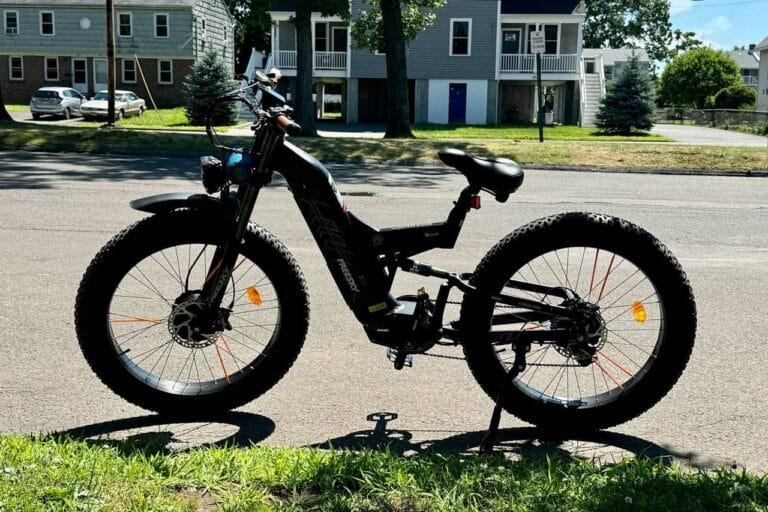
![Qlife Triker Electric Bike Review ([year]): A Stable, Folding 3-Wheel Grocery Hauler Qlife Triker Electric Bike Review: A Stable, Folding 3-Wheel Grocery Hauler](https://goebikelife.com/wp-content/uploads/2025/03/Qlife-Triker-E-Bike-Review-768x512.jpg)
![Bluvall K10 Trail Review ([year]): Dual-Motor Power, Real-World Range & Comfort Bluvall K10 Trail Review: Dual-Motor Power, Real-World Range & Comfort](https://goebikelife.com/wp-content/uploads/2025/10/Bluvall-K10-Trail-eBike-GoEBikeLife-768x512.jpg)
